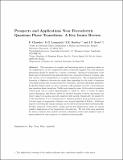Files in this item
Prospects and applications near ferroelectric quantum phase transitions : a key issues review
Item metadata
| dc.contributor.author | Chandra, P. | |
| dc.contributor.author | Lonzarich, Gilbert G. | |
| dc.contributor.author | Rowley, S. E. | |
| dc.contributor.author | Scott, J. F. | |
| dc.date.accessioned | 2018-09-27T23:44:43Z | |
| dc.date.available | 2018-09-27T23:44:43Z | |
| dc.date.issued | 2017-11 | |
| dc.identifier | 250572361 | |
| dc.identifier | 0a3caf08-290f-4cf8-ab13-a6681fc3dd5e | |
| dc.identifier | 85032788765 | |
| dc.identifier | 000412200800001 | |
| dc.identifier.citation | Chandra , P , Lonzarich , G G , Rowley , S E & Scott , J F 2017 , ' Prospects and applications near ferroelectric quantum phase transitions : a key issues review ' , Reports on Progress in Physics , vol. 80 , no. 11 , 112502 . https://doi.org/10.1088/1361-6633/aa82d2 | en |
| dc.identifier.issn | 0034-4885 | |
| dc.identifier.other | ArXiv: http://arxiv.org/abs/1704.07270v1 | |
| dc.identifier.uri | https://hdl.handle.net/10023/16096 | |
| dc.description.abstract | The emergence of complex and fascinating states of quantum matter in the neighborhood of zero temperature phase transitions suggests that such quantum phenomena should be studied in a variety of settings. Advanced technologies of the future may be fabricated from materials where the cooperative behavior of charge, spin and current can be manipulated at cryogenic temperatures. The progagating lattice dynamics of displacive ferroelectrics make them appealing for the study of quantum critical phenomena that is characterized by both space- and time-dependent quantities. In this Key Issues article we aim to provide a self-contained overview of ferroelectrics near quantum phase transitions. Unlike most magnetic cases, the ferroelectric quantum critical point can be tuned experimentally to reside at, above or below its upper critical dimension; this feature allows for detailed interplay between experiment and theory using both scaling and self-consistent field models. Additional degrees of freedom like charge and spin can be added and characterized systematically. Satellite memories, electrocaloric cooling and low-loss phased-array radar are among possible applications of low-temperature ferroelectrics. We end with open questions for future research that include textured polarization states and unusual forms of superconductivity that remain to be understood theoretically. | |
| dc.format.extent | 24 | |
| dc.format.extent | 2662094 | |
| dc.language.iso | eng | |
| dc.relation.ispartof | Reports on Progress in Physics | en |
| dc.subject | Quantum phase transitions | en |
| dc.subject | Ferroelectrics | en |
| dc.subject | Quantum criticality | en |
| dc.subject | QC Physics | en |
| dc.subject | T Technology | en |
| dc.subject | NDAS | en |
| dc.subject.lcc | QC | en |
| dc.subject.lcc | T | en |
| dc.title | Prospects and applications near ferroelectric quantum phase transitions : a key issues review | en |
| dc.type | Journal article | en |
| dc.contributor.institution | University of St Andrews. School of Chemistry | en |
| dc.contributor.institution | University of St Andrews. School of Physics and Astronomy | en |
| dc.contributor.institution | University of St Andrews. Condensed Matter Physics | en |
| dc.identifier.doi | 10.1088/1361-6633/aa82d2 | |
| dc.description.status | Peer reviewed | en |
| dc.date.embargoedUntil | 2018-09-28 |
This item appears in the following Collection(s)
Items in the St Andrews Research Repository are protected by copyright, with all rights reserved, unless otherwise indicated.

